| کد مقاله | کد نشریه | سال انتشار | مقاله انگلیسی | نسخه تمام متن |
|---|---|---|---|---|
| 4691295 | 1636722 | 2016 | 17 صفحه PDF | دانلود رایگان |

• The Trans-European Suture Zone developed on the attenuated Baltica crust.
• Acid magmatism occurred at the SW border of the TESZ in the dextral wrench regime.
• Granitoid intrusions at ~ 300 Ma were followed by volcanism up to ~ 293 Ma.
• Thickening in the Variscan foreland contributed to magmatic processes.
The Trans-European Suture Zone (TESZ) links the East and West European Platforms. It is concealed under Meso-Cenozoic cover. Available seismic data show that the lower crustal layer in the TESZ is an attenuated, ~ 200 km wide, SW margin of Baltica. The attenuation occurred when Rodinia broke-up, which gave rise to evolution of the thinned, thus relatively unstable margin of Baltica. It accommodated accretions during Phanerozoic events. We focus on acid magmatism, specifically granitoid, observed close to the SW border of the TESZ in Poland. This border is defined by the Dolsk Fault Zone (DFZ) and the Kraków-Lubliniec Fault Zone (KLFZ) on which dextral wrenching developed as a result of the Variscan collision between Laurussia and Gondwana. The granitoids at the DFZ and KLFZ were dated at ~ 300 Ma. In the Variscan foreland that overlaps the TESZ, orogenic thickening continued to ~ 307–306 Ma, possibly contributed to melting of the thickened upper continental crust (εNd300 = − 6.0 to − 4.5) and triggered the tectonically controlled magmatism. The wrenching on the TESZ border faults caused tensional openings in the basement, which promoted magmatic centers with extrusions of rhyolites and extensive ignimbrites. The Chrzypsko–Paproć and Małopolska magmatic centers were developed at the DFZ and KLFZ, respectively. The magmatic edifices commenced at ~ 302 Ma with relatively poorly evolved granites, which carried both suprasubduction and anorogenic signatures, then followed by more evolved volcanic rocks (up to 293 Ma). Their geochemistry and inherited zircons suggest that the felsic magmas were mainly derived from upper crustal rocks, with some mantle additions, which included Sveconorwegian and older Baltican components. The complex TESZ, with Baltica basement in the lower crust, was susceptible to transient effects of mantle upwelling that occurred by the end of the Variscan orogeny and resulted in an episode of the “flare-up” magmatism in the North German–Polish Basin.
Journal: Tectonophysics - Volume 675, 22 April 2016, Pages 227–243